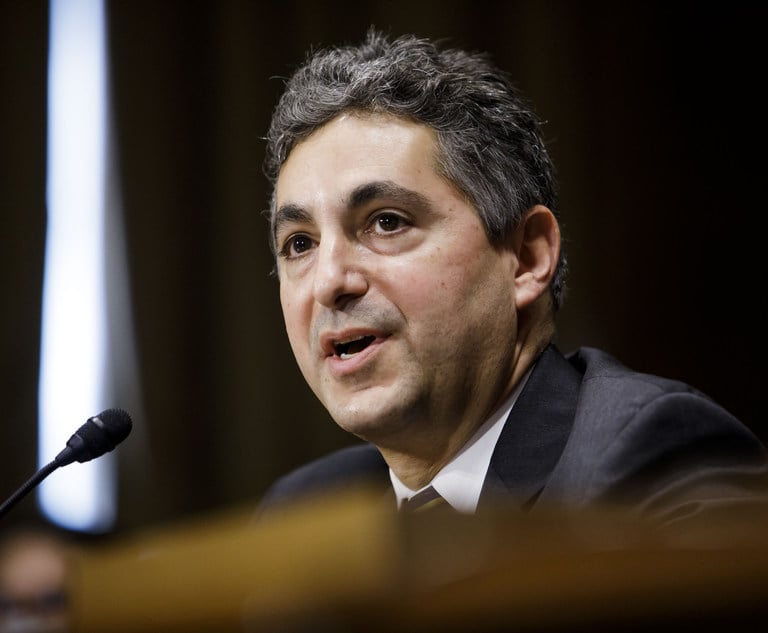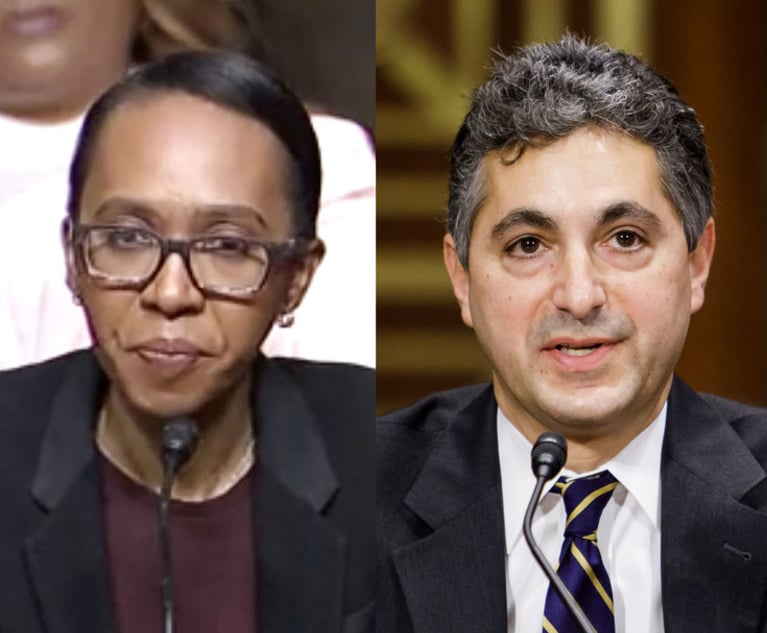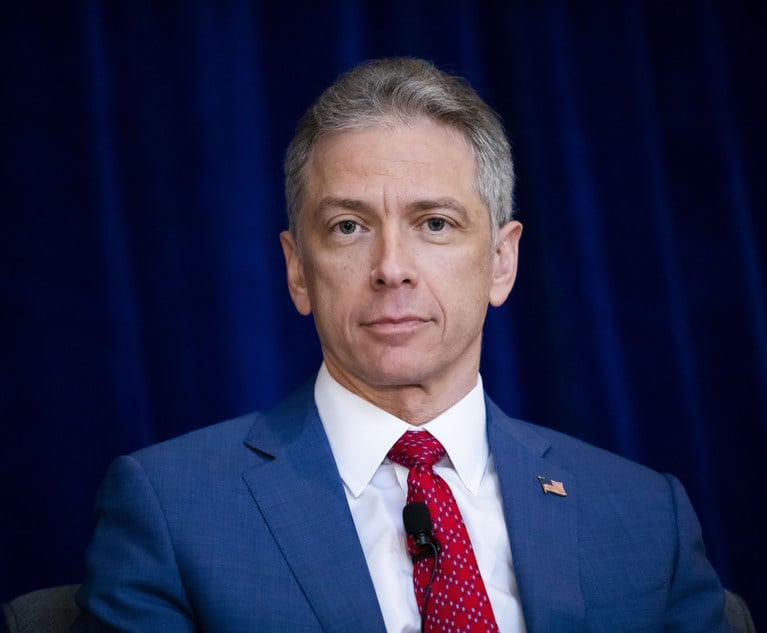Skilled in the Art: It's Tough Out There in IP Land!
A newly unsealed bench verdict reveals the details of a knock-down, drag-out patent fight between WashU in St. Louis and the University of Wisconsin. Plus, what really goes on in Judge William Alsup's so-called shootouts where accused infringers may wind up in "injunction city."
December 18, 2018 at 09:15 PM
10 minute read
Welcome to Skilled in the Art. I'm Law.com IP reporter Scott Graham.
You'd think in the academic world that universities would treat each other with fairness and respect, right? I mean, college football players and coaches shake hands even after the toughest, chippiest football games. Well, that level of goodwill was absent from the University of Wisconsin's patent partnership with Washington University in St. Louis. A $31 million judgment for WashU was entered a few weeks ago, but now the bench verdict has been unsealed and it is not a pretty picture for Wisconsin's tech transfer unit. I've got details below.
Plus U.S. District Judge William Alsup explains his “shootout procedure” for patent cases and the “day of reckoning” it quickly imposes on parties.
As always you can email me your thoughts and follow me on Twitter.
➤➤ Want to receive Skilled in the Art by email? Sign up here.
 Michael Jacobs, Morrison & Foerster partner (Photo: Jason Doiy, ALM)
Michael Jacobs, Morrison & Foerster partner (Photo: Jason Doiy, ALM)Higher Education Meets Lower Contract Ethics
Universities collaborate with each other all the time on scientific research. When that collaboration leads to patentable technology, the schools usually strike a deal to share the licensing revenue.
Can you name a famous piece of litigation that sprang up from a fight between universities over such an inter-institutional agreement? The answer is they're pretty rare. As E.J. Brandt, formerly of Washington University in St. Louis' tech transfer office, put it in a recent trial, “Universities aren't out to do a job on each other or anything like that, so they try to be fair on both sides and work things out.”
Well, now we have a federal court opinion from a knock-down, drag-out fight over an agreement that Brandt signed with the University of Wisconsin. U.S. District Judge Joseph Bataillon's 191-page opinion lays out in sordid detail the job Wisconsin's tech transfer office did on WashU over a patent that helped launch Abbott Laboratories' $6 billion kidney drug Zemplar.
The Wisconsin Alumni Research Foundation, or WARF, took the lead on patenting and commercializing the 5,597,815 patent, which was the result of a collaboration between the two schools. WARF then “grossly undervalued” the '815 patent while overvaluing its own contributions to the Zemplar portfolio, and concealed that information from WashU for nearly 20 years. In the meantime, “WARF appropriated $426.5 million in earned royalties from Abbott for itself, while remitting a little over $1 million to Washington University,” Bataillon wrote (emphasis his). Had the patents been valued fairly, WashU's cut would have been closer to $60 million, in Bataillon's estimation.
WARF engineered the feat by designating two of its own Zemplar patents as the most valuable, while relegating the WashU collaboration to a group of 30 “ancillary” patents, most of which were obsolete, abandoned or “had nothing to do with” the licensed compound, Bataillon found. When WashU asked for clarification, WARF responded with “misstatements, half truths and misdirection,” the judge wrote. It claimed to be constrained by a confidentiality clause with Abbott that didn't actually exist.
WARF “paid millions and millions of dollars in royalties to dozens of inventors at the University of Madison-Wisconsin who made absolutely no contribution whatsoever to Zemplar,” Bataillon wrote. Meanwhile, WashU professor Eduardo Slatopolsky, “whose seminal study led directly to the issuance of one of the most important patents licensed to Abbott—received only a fraction of the royalties as those other inventors.”
WashU's lead counsel, Morrison & Foerster partner Michael Jacobs, said he expects Bataillon's opinion to generate a lot of buzz in the academic world. “There are basically zero reported cases involving this kind of inter-university scenario,” he said. With academic researcher mobility on the rise, inter-institutional agreements covering patent rights are going to become “more and more important.”
MoFo associates Christopher Robinson and Elizabeth Ann Patterson and Ashby & Geddes director Andrew Mayo rounded out WashU's trial team.
A few other quick highlights from Bataillon's findings:
➤ WARF calculated that the '815 patent was worth less than 1 percent of the value of its Zemplar license, even though it told Abbott in 1998 that the '815 patent “directly supports the Abbott Zemplar product.”
➤ Following Zemplar's 1998 launch, WashU licensing coordinator Mary Loidawrote to WARF licensing associate Gayle Kirkpatrick, asking if WashU could see WARF's agreement with Abbott. Kirkpatrick emailed back: “As per confidentiality provisions, I am not at liberty to provide you copies of our license agreements with any other parties. I would think that your office would have the same restrictions.” WARF's agreements with Abbott contained no such confidentiality provisions, Bataillon found.
➤ When WashU again requested more information in 2001, WARF explained that it considered method-of-treatment patents like the '815 to be low value—even though it had assigned one of its own method-of-treatment patents 35 percent of the Zemplar license.
➤ WARF and Abbott asserted the '815 patent against generic drug makers in 2012 litigation without notifying WashU. When WashU researcher Slatopolsky was served with a subpoena, WARF's counsel responded on his behalf without notifying WashU. It wasn't until WashU itself was subpoenaed that officials became aware of the lawsuits and began to realize the value of the patent.
“Not only did WARF fail to inform WashU about its assertion of the ʼ815 patent in the generic litigation, but WARF took affirmative action to keep WashU from learning these facts,” Bataillon concluded. “All these events underscore the lengths to which WARF went to keep WashU in the dark as to the ʼ815 patent's true relative value.”
WARF was represented by Finnegan, Henderson, Farabow, Garrett & Dunnerand by Morris, Nichols, Arsht & Tunnell. Finnegan partner Robert Shaffer argued to the court that Wisconsin professor Hector DeLuca had provided by far the most value by discovering the actual compound used in Zemplar; that Slatopolsky's research was just one small portion of the voluminous studies submitted to the FDA in support of Zemplar; that Abbott never used the '815 patent until shortly before the generic litigation; and that WARF acted fairly by assigning relative values to the patents based on its standard practices.
He also argued that WashU sat on its hands for far too long before suing. “If there is a good reason for statute of limitations to even exist, this case is it,” Shaffer said in his opening statement.
Bataillon ultimately ruled that WARF was equitably estopped from asserting the statute of limitations and awarded WashU $31 million covering 2007 through 2013.
A Shootout at the Alsup Corral
As my former ALM colleague Ginny LaRoe pointed out many years ago, U.S. District Judge William Alsup is a courtroom scientist who especially enjoys making bold experiments in patent cases. On Monday I learned about his latest innovation.
Alsup calls it the shootout. He instructs the patentee to pick its strongest asserted claim and the accused infringer to pick the weakest. The judge then conducts summary judgment and trial—if necessary—on an expedited schedule. This was the procedure that led to Friday's defense verdict for Juniper Networks in a cybersecurity dispute with Finjan.
Alsup has been conducting shootouts since at least 2017, but the Finjan case provides the judge's rationale in his own words. As Alsup explained back in February, few patent cases are close calls that require a jury trial. In two out of three, it turns out that one side is “way off base,” Alsup said, according to a transcript.
Under the shootout, if the accused infringer defeats the patent owner's strongest claim, the accused infringer might get sanctions. “And they will have to pay that right off the bat. Could be hundreds of thousands of dollars for having brought a bogus claim.”
Conversely, if the patent owner prevails, “it's injunction city,” Alsup said. “You don't have to wait until the end of the case. Whamo, the product goes off the shelf.”
“So this is why it's called a shoot-out,” the judge explained. “It's like the shoot-out at the OK Corral in Tombstone, Arizona. Where the lawyers go in there and they just shoot it out and one of them comes out alive.”
Alsup then thought better of that. “That's a terrible example to use these days so I'm going to take that back. Maybe I'll call it something else.”
One other benefit, according to the judge: Once accused infringers start targeting the weakest claims, patent owners often start dropping them from the case, which simplifies things, Alsup said. “This gets to the heart of the matter so quickly and so cleanly, instead of you all treating me like your early neutral evaluation judge and two years later I'm still trying to figure out which end is up,” the judge said.
“So that's the way we're going to proceed,” Alsup concluded. “Go back and tell your clients that the day of reckoning is close at hand.”
(Illustration by Jason Doiy, ALM)
Pranger Law Picks Up a Partner
It's been awhile since I had some lateral news. But I'm glad to report today that San Francisco IP boutique Pranger Law has hired Scott Lonardo from Orrick, Herrington & Sutcliffe.
Lonardo's practice focuses on all aspects of IP, with emphasis on trademark litigation and counseling. Before joining Orrick he was a clerk for Judge Kathleen O'Malley, first in the Northern District of Ohio and then at the Federal Circuit.
“Scott offers a wealth of knowledge in the world of IP litigation, and he is a perfect addition as Pranger continues to grow and expand,” Managing Partner Holly Pranger said in a statement, adding that the firm plans to expand into Silicon Valley next year.
Emoting, and then Suing
I'm trying to remember, I think it was, way back in mid-2000s or so that video games became a niche IP practice area. Now I'm starting to think that the emoting avatar could become its own specialty.
My ALM colleague Richard Binder reported today that actor Alfonso Ribeiro has filed the latest suit against Epic Games over an emote, a dance move Fortniteplayers can purchase to personalize their avatars. Ribeiro states in the suit that he created the dance commonly known as “the Carlton,” (named after his character on The Fresh Prince of Bel-Air). “Twenty-seven years later, the dance remains distinctive, immediately recognizable, and inextricably linked to Ribeiro's identity, celebrity, and likeness,” his lawsuit says.
Ribeiro's suit follows on the heels of rapper 2 Milly suing Epic over a Fortnite emote that allegedly borrows from his signature move, the Milly Rock.
Binder reports that the suits may face an uphill battle because, according to the U.S. Copyright Office, individual movements or dance steps by themselves are not copyrightable. But he notes that at least one choreographer got some satisfactionfrom from the makers of Fortnite.
That's all from Skilled in the Art today. I'll see you all again on Friday.
This content has been archived. It is available through our partners, LexisNexis® and Bloomberg Law.
To view this content, please continue to their sites.
Not a Lexis Subscriber?
Subscribe Now
Not a Bloomberg Law Subscriber?
Subscribe Now
NOT FOR REPRINT
© 2025 ALM Global, LLC, All Rights Reserved. Request academic re-use from www.copyright.com. All other uses, submit a request to [email protected]. For more information visit Asset & Logo Licensing.
You Might Like
View All
Skilled in the Art With Scott Graham: I'm So Glad We Had This Time Together

Design Patent Appeal Splinters Federal Circuit Panel + Susman Scores $163M Jury Verdict + Finnegan Protects Under Armour's House
Trending Stories
- 1'A Death Sentence for TikTok'?: Litigators and Experts Weigh Impact of Potential Ban on Creators and Data Privacy
- 2Bribery Case Against Former Lt. Gov. Brian Benjamin Is Dropped
- 3‘Extremely Disturbing’: AI Firms Face Class Action by ‘Taskers’ Exposed to Traumatic Content
- 4State Appeals Court Revives BraunHagey Lawsuit Alleging $4.2M Unlawful Wire to China
- 5Invoking Trump, AG Bonta Reminds Lawyers of Duties to Noncitizens in Plea Dealing
Who Got The Work
J. Brugh Lower of Gibbons has entered an appearance for industrial equipment supplier Devco Corporation in a pending trademark infringement lawsuit. The suit, accusing the defendant of selling knock-off Graco products, was filed Dec. 18 in New Jersey District Court by Rivkin Radler on behalf of Graco Inc. and Graco Minnesota. The case, assigned to U.S. District Judge Zahid N. Quraishi, is 3:24-cv-11294, Graco Inc. et al v. Devco Corporation.
Who Got The Work
Rebecca Maller-Stein and Kent A. Yalowitz of Arnold & Porter Kaye Scholer have entered their appearances for Hanaco Venture Capital and its executives, Lior Prosor and David Frankel, in a pending securities lawsuit. The action, filed on Dec. 24 in New York Southern District Court by Zell, Aron & Co. on behalf of Goldeneye Advisors, accuses the defendants of negligently and fraudulently managing the plaintiff's $1 million investment. The case, assigned to U.S. District Judge Vernon S. Broderick, is 1:24-cv-09918, Goldeneye Advisors, LLC v. Hanaco Venture Capital, Ltd. et al.
Who Got The Work
Attorneys from A&O Shearman has stepped in as defense counsel for Toronto-Dominion Bank and other defendants in a pending securities class action. The suit, filed Dec. 11 in New York Southern District Court by Bleichmar Fonti & Auld, accuses the defendants of concealing the bank's 'pervasive' deficiencies in regards to its compliance with the Bank Secrecy Act and the quality of its anti-money laundering controls. The case, assigned to U.S. District Judge Arun Subramanian, is 1:24-cv-09445, Gonzalez v. The Toronto-Dominion Bank et al.
Who Got The Work
Crown Castle International, a Pennsylvania company providing shared communications infrastructure, has turned to Luke D. Wolf of Gordon Rees Scully Mansukhani to fend off a pending breach-of-contract lawsuit. The court action, filed Nov. 25 in Michigan Eastern District Court by Hooper Hathaway PC on behalf of The Town Residences LLC, accuses Crown Castle of failing to transfer approximately $30,000 in utility payments from T-Mobile in breach of a roof-top lease and assignment agreement. The case, assigned to U.S. District Judge Susan K. Declercq, is 2:24-cv-13131, The Town Residences LLC v. T-Mobile US, Inc. et al.
Who Got The Work
Wilfred P. Coronato and Daniel M. Schwartz of McCarter & English have stepped in as defense counsel to Electrolux Home Products Inc. in a pending product liability lawsuit. The court action, filed Nov. 26 in New York Eastern District Court by Poulos Lopiccolo PC and Nagel Rice LLP on behalf of David Stern, alleges that the defendant's refrigerators’ drawers and shelving repeatedly break and fall apart within months after purchase. The case, assigned to U.S. District Judge Joan M. Azrack, is 2:24-cv-08204, Stern v. Electrolux Home Products, Inc.
Featured Firms
Law Offices of Gary Martin Hays & Associates, P.C.
(470) 294-1674
Law Offices of Mark E. Salomone
(857) 444-6468
Smith & Hassler
(713) 739-1250











